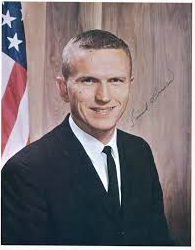
NASA astronaut and aviation pioneer Frank Borman, who led the first manned mission to orbit the moon, dies at 95.
Frank Borman, the commander of Apollo 8, the first manned mission to orbit the Moon, has passed away at the age of 95. His death was confirmed by NASA on Tuesday in Billings, Montana.
Borman’s most notable achievement came during the historic Apollo 8 mission in 1968. He, along with his crew members James Lovell and William Anders, made history by orbiting the Moon, an essential step that paved the way for the first Moon landing the following year.
In addition to his remarkable NASA career, Borman also served as the head of Eastern Airlines during a turbulent period in the 1970s and early 1980s, after retiring from the astronaut corps. However, it was his time with NASA that earned him lasting recognition. As commander of Apollo 8, Borman and his crew were the first humans to witness Earth from space as a distant, fragile sphere.
NASA Administrator Bill Nelson paid tribute to Borman, calling him “a true American hero” and praising his lifelong passion for aviation and space exploration. Nelson also noted Borman’s deep affection for his wife, Susan, which surpassed even his devotion to his profession.
The Apollo 8 mission launched from Cape Canaveral on December 21, 1968, and after three days in transit, entered lunar orbit on Christmas Eve. Over the next two days, the crew orbited the Moon 10 times before returning to Earth on December 27.
On Christmas Eve, the astronauts made a live broadcast from space, reading from the Book of Genesis, an iconic moment in space history: “In the beginning, God created the heaven and the earth. And the earth was without form, and void; and darkness was upon the face of the deep.”
Borman ended the broadcast by wishing the world a Merry Christmas, saying, “And from the crew of Apollo 8, we close with good night, good luck, a Merry Christmas, and God bless all of you — all of you on the good Earth.”
Borman and Lovell had previously flown together on the Gemini 7 mission in 1965. Borman famously recalled the cramped conditions of the Gemini spacecraft, likening it to a “super-duper, plush touring bus” compared to the more confined Apollo modules.
In his autobiography, Countdown: An Autobiography, Borman revealed that the original plan for Apollo 8 had been to orbit Earth. However, after the success of Apollo 7 in October 1968, which demonstrated the feasibility of long-duration spaceflights, NASA decided to aim for a Moon mission. Borman also acknowledged that part of the reasoning behind the mission was the desire to get to the Moon ahead of the Soviet Union.
Borman reflected on the moment when the crew saw the Earth from space, saying it was an emotional experience. “We were the first humans to see the world in its majestic totality. I was sure our thoughts were identical — of our families on that spinning globe. And maybe we shared another thought I had, This must be what God sees.”
During the mission, Anders famously captured the iconic “Earthrise” photograph, showing Earth rising above the Moon’s barren surface, a moment that remains one of the most significant images in the history of space exploration.











